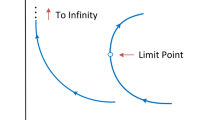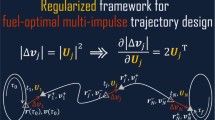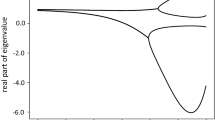Abstract
This note presents a novel approach to maintain three-dimensional multi-tethered satellite formation in space. For a formation consisting of a main body connected by tethers with several deputy satellites (the so-called “hub-and-spoke” configuration) we demonstrate that under proper choice of the system’s parameters the deputy satellites can move along Lissajous curves in the plane normal to the local vertical with all tethers stretched; the total force due to the tension forces acting on the main satellite is balanced in a way allowing it to be in relative equilibrium strictly below or strictly above the system’s center of mass. We analyze relations between the system’s essential parameters and obtain conditions under which the proposed motion does take place. We also study analytically the motion stability for different configurations and whether the deputy satellites can collide or the tethers can entangle. Our theoretical findings are corroborated and validated by numerical experiments.







Similar content being viewed by others
References
Alary, D., Andreev, K., Boyko, P., Ivanova, E., Pritykin, D., Sidorenko, V., et al.: Dynamics of multi-tethered pyramydal satellite formation. Acta Astronaut. 117, 222–232 (2015)
Armstrong, M.A.: Basic Topology. Springer, New York (1983)
Arnold, V.I.: Ordinary Differential Equations. MIT Press, Cambridge (1978)
Avanzini, G., Fedi, M.: Refined dynamical analysis of multi-tethered satellite formations. Acta Astronaut. 84, 36–48 (2013)
Avanzini, G., Fedi, M.: Effects of eccentricity of the reference orbit on multi-tethered satellite formations. Acta Astronaut. 94, 338–350 (2014)
Bekey, I.: Tethers open new space options. Astronaut. Aeronaut. 21, 23–40 (1983)
Cai, Z., Zhao, J., Peng, H., Qi, Z.: Nonlinear control of rotating multi-tethered formations in Halo orbits. Int. J. Comput. Methods 11, 1344008 (2014). (26 pages)
Celletti, A., Sidorenko, V.V.: Some properties of dumbbell satellite attitude dynamics. Celest. Mech. Dyn. Astron. 101, 105–126 (2008)
Clohessy, W.H., Wiltshire, R.S.: Terminal guidance system for satellite rendezvous. J. Aerosp. Sci. 27, 653–658 (1960)
Gantmacher, F.R.: Applications of the Theory of Matrices. Interscience, New York (1959)
Nayfeh, A.H.: Perturbations Methods. Wiley-Interscience, New York (1973)
Panosian, S., Seubert, C.R., Schaub, H.: Tethered Coulomb structure applied to close proximity situational awareness. AIAA J. Spacecr. Rockets 49, 1183–1193 (2012)
Pizarro-Chong, A., Misra, A.K.: Dynamics of multi-tethered satellite formations containing a parent body. Acta Astronaut. 63, 1188–1202 (2008)
Seubert, C.R., Schaub, H.: Tethered Coulomb structures: prospects and challenges. J. Astronaut. Sci. 57, 347–348 (2009)
Seubert, C.R., Panosian, S., Schaub, H.: Attitude and power analysis of multi-tethered two-node tethered Coulomb structures. AIAA J. Spacecr. Rockets 48, 1033–1045 (2011)
Sidorenko, V.V., Celletti, A.: A “spring-mass” model of tethered satellite systems: properties of planar periodic motions. Celest. Mech. Dyn. Astron. 107, 209–231 (2010)
Wong, B., Misra, A.: Planar dynamics of variable length multi-tethered spacecraft near collinear Lagrangian points. Acta Astronaut. 63, 1178–1187 (2008)
Zhao, J., Cai, Z.: Nonlinear dynamics and simulation of multi-tethered satellite formations in Halo orbits. Acta Astronaut. 63, 673–681 (2008)
Acknowledgments
The authors first conceived the idea of the motion described in this paper during the dynamical analysis of the rotating multi-tethered satellite system (Alary et al. 2015), and the authors sincerely thank their collaborators Didier Alary, Kirill Andreev, Pavel Boyko, Elena Ivanova, and Cyrille Tourneur for the warm and stimulating atmosphere of that study. The work of one of the authors (DY) on the present paper was supported by Russian Science Foundation (Project 14-50-00150).
Author information
Authors and Affiliations
Corresponding author
Electronic supplementary material
Below is the link to the electronic supplementary material.
Supplementary material 1 (avi 24262 KB)
Appendices
Appendix
Proof of Proposition 1
Statements (a) and (d) are very simple, so we only provide proofs for (b) and (c).
(b) Suppose that the satellite i collides with the satellite j at the time moment \(\tau \). The condition \(x_i(\tau )=x_j(\tau )\) admits two series of solutions:
-
1.
\(2\pi p\left( \tau +\frac{i}{N}\right) +\varphi _x= 2\pi \left[ p\left( \tau +\frac{j}{N}\right) +n_x\right] +\varphi _x\) with some integer \(n_x\), that is
$$\begin{aligned} \frac{i-j}{N}=\frac{n_x}{p}. \end{aligned}$$ -
2.
\(2\pi p\left( \tau +\frac{i}{N}\right) +\varphi _x= 2\pi \left[ \frac{1}{2}+n_x-p\left( \tau +\frac{j}{N}\right) \right] -\varphi _x\) with some integer \(n_x\), that is
$$\begin{aligned} \tau =\frac{1}{2}\left[ \frac{1}{p}\left( \frac{1}{2}+n_x-\frac{\varphi _x}{\pi }\right) - \frac{i+j}{N}\right] . \end{aligned}$$
The condition \(y_i(\tau )=y_j(\tau )\) has similar series but with q instead of p, \(\varphi _y\) instead of \(\varphi _x\) and \(n_y\) instead of \(n_x\).
Thus there are four possibilities for the satellites to collide: an element in series 1 or 2 for the coordinate x must occur simultaneously with an element in series 1 or 2 for the coordinate y. Let us deal with these cases one by one.
-
1.
Series 1 for x and series 1 for y—impossible because p and q are co-prime and \(-N<i-j<N\).
-
2.
Series 2 for x and series 1 for y. Series 1 for y has non-trivial solutions iff N and q are not co-prime. If a non-trivial solution exists, the time moment \(\tau \) is found from series 2 for x. Thus in this series collisions occur iff N and q are not co-prime.
-
3.
Series 1 for x and series 2 for y. Similarly, collisions occur iff N and \(p\ \) are not co-prime.
-
4.
Series 2 for x and series 2 for y. Equating \(\tau \) from both series, we obtain
$$\begin{aligned} \frac{1}{p}\left( \frac{1}{2}+n_x-\frac{{\varphi }_x}{\pi }\right) = \frac{1}{q}\left( \frac{1}{2}+n_y-\frac{{\varphi }_y}{\pi }\right) \end{aligned}$$whence
$$\begin{aligned} n_xq-n_yp =\frac{{q\varphi }_x-{p\varphi }_y}{\pi }+\frac{p-q}{2}. \end{aligned}$$
Since p and q are co-prime, with \(n_x,n_y\) running over all possible integers, the left side also runs over all possible integers, i.e. collisions in this case happen iff the right side is an integer.
(c) Like in the proof of (b), we obtain two series of relations from the condition \(x_i{\mathrm{(}}\tau {\mathrm{)=}}x_{{\mathrm{j}}}{\mathrm{(}}\tau \mathrm{)}\). However, the first series takes the form
and has no non-trivial solutions, because \(-N < i-j <N\). This leaves the second series, which has the form
Like before, we equate \(\tau \) from the series for x and y and obtain
whence
As \(n_x{\mathrm{,\ }}n_y\) run over all integer values, the expression \(qn_x{\mathrm{-}}pn_y\) also takes all integer values. If \(N\ge 3\), the sum \(i+j\) for all possible pairs of different numbers from 1 to N assumes all possible integer values modulo N. Thus the expression in the left side takes all possible integer values divisible by the greatest common divisor of N and \(q-p\). On the other hand, if \(N=2\), then \(i+j=3\) and the above relation simplifies to the requirement that
be integer.
Proof of Proposition 2
(a) For a closed curve \({{\mathrm{(}}x\left( \tau \right) ,y(\tau ))}_{\tau \in [0,1]}\) not containing the origin, the number w of its rotations about the origin can be written as
assuming that the intersections of the curve with the x coordinate axis are non-degenerate. We will apply this formula to
We consider separately the two types of formations.
Type I In this case
so that
where \(w_*\) is the winding number of the Lissajous curve
We have
Moreover, with this choice of \(\tau \) we have \(\dot{y}_*\left( \tau \right) >0\) for even s and \(\dot{y}_*\left( \tau \right) <0\) for odd s. Applying the formula for the winding number, we obtain
with some (unimportant) phase constant \(\varphi _*\).
Now consider separately the cases when both p, q are odd and when one of them is even.
Let both p, q be odd. Since p, q are co-prime, the values \((\pi ps/q){\mathrm{mod}}\ 2\pi \) run over the values in the set \(Z_{2q}=\left\{ \pi r/q \right\} ^{2q-1}_{r=0}\) as s runs over \(1,2,\ldots ,2q\). Then the quantity \({\cos \left( \frac{\pi ps}{q}+{\varphi }_*\right) \ }\) takes equally many positive and negative values as s runs over \(1,2,\ldots ,2q\). Now, if s runs only over even values \(2,\ldots ,2q\), then \((\pi ps/q){\mathrm{mod}}\ 2\pi \) runs over the values in the set \(Z_q=\left\{ 2\pi r/q\right\} ^{q-1}_{r=0}\). Then, since q is odd, the number of positive and negative values taken by \({\cos \left( \frac{\pi ps}{q}+{\varphi }_*\right) \ }\), as s runs only even values \(2,\ldots ,2q\), differs by 1. It follows that
Now let one of p, q be even; without loss of generality we can assume that it is q. We can then repeat the above argument, but since q is now even, we conclude that \({\cos \left( \frac{\pi ps}{q}+{\varphi }_*\right) \ }\) takes equally many negative and positive values as s runs over the even or odd subset of \(1,2\ldots ,2q\). It follows that \(w_*=\frac{1}{2}\left( 0-0\right) =0\).
We have thus proved statement (a) for Type I formation.
Type II In this case
which leads to
with some phase constant \({\varphi }_*\) not depending on i, j. The statement (a) then follows just like in case of Type I.
(b) From the proof of (a), \(w_{i,j}=w_*\mathrm{sign}\left( x_0y_0\right) {\mathrm{sign}}(f_{j-i})\), where we set
Note first that if \(q-p\) is divisible by 2N, then \(f_s=\sin ^2 \left( \pi p s/N\right) >0\) for all s not divisible by N (recall that N and p are co-prime by the assumption of no collisions). Accordingly, \(w_{i,j}=w_*{\mathrm{sign}}\left( x_0y_0\right) \) for all \(i,j=1,\ldots ,N\) with \(i\ne j\). Similarly, \(w_{i,j}=-w_*\mathrm{sign}\left( x_0y_0\right) \) if \(q+p\) is divisible by 2N.
Now suppose that neither of \(q-p,\ q+p\) is divisible by 2N. We need to show that \(f_s\) takes both positive and negative values as s runs over \(1,2,\ldots ,N-1\). Since \(f_N=f_0=0\) and \(f_{2N-s}=f_s\), it suffices to show that \(\sum ^{2N-1}_{s=0}{f_s}=0.\) But that immediately follows from the hypothesis and the identity
The presence of strong entanglement follows from the presence of different winding numbers, since under a weak homotopy the winding number (possibly nonzero) must be the same for all pairs.
Rights and permissions
About this article
Cite this article
Yarotsky, D., Sidorenko, V. & Pritykin, D. Three-dimensional multi-tethered satellite formation with the elements moving along Lissajous curves. Celest Mech Dyn Astr 125, 309–332 (2016). https://doi.org/10.1007/s10569-016-9683-2
Received:
Revised:
Accepted:
Published:
Issue Date:
DOI: https://doi.org/10.1007/s10569-016-9683-2




